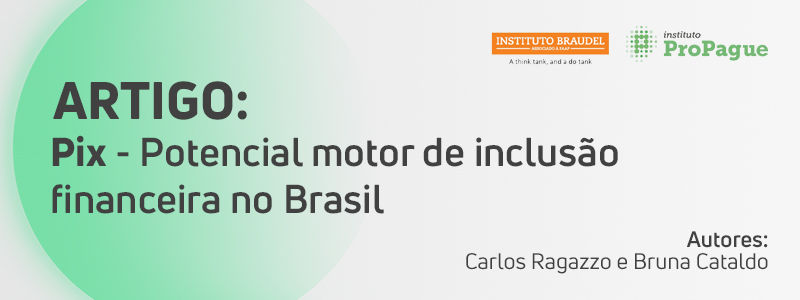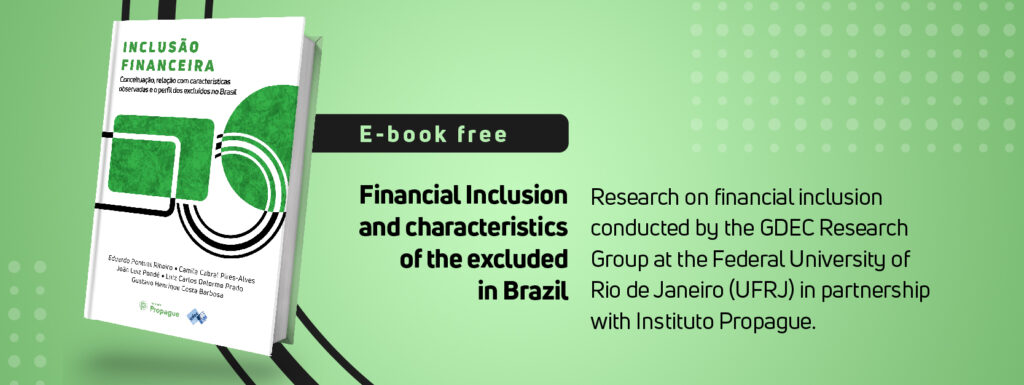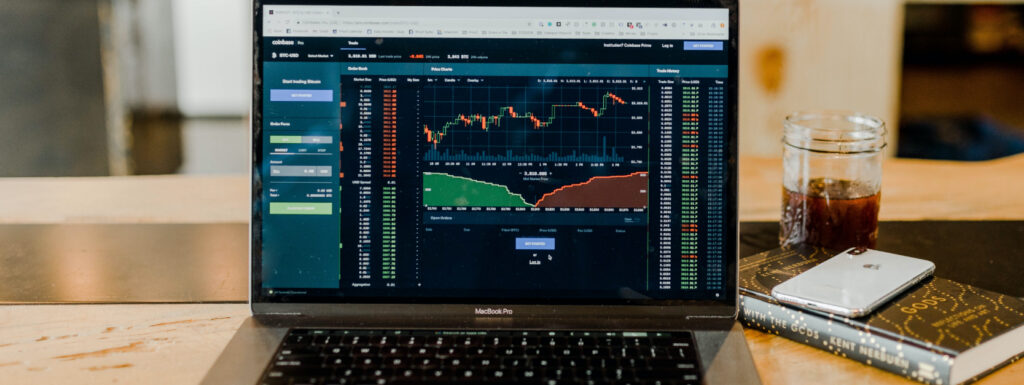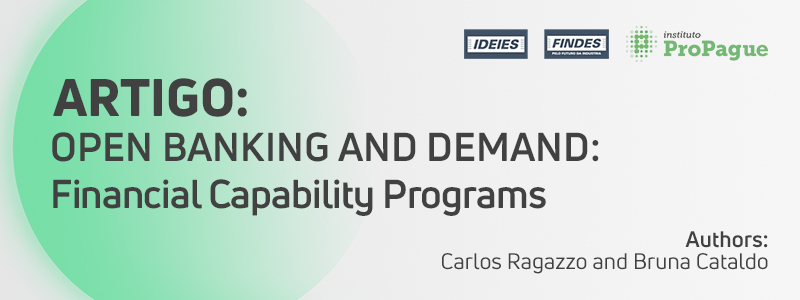Article written for the Instituto Fernand Braudel de Economia Mundial.
Authors: Carlos Ragazzo, professor at FGV-Rio and President of the Advisory Board at Instituto Propague, and Bruna Cataldo, researcher at Instituto Propague.
The problem of financial exclusion is global: the World Bank’s most recent report on the subject indicates that 1.7 billion adults did not have bank accounts in 2017, a problem more concentrated in middle-income and poor countries. Although the number materializes the size of the problem for social development, the same report indicates that the movement of financial inclusion has accelerated since 2014 internationally, with the increased use of cell phones and internet in several regions, including by those from vulnerable social backgrounds. The process has advanced in the three years since the release of the report, and the digitization and implementation of instant payments have promoted large-scale financial inclusion in countries such as India, China, and Thailand.
Brazil still has a long way to go with 45 million unbanked people, and this paper seeks to argue that the traditional path of inducing participation in the financial ecosystem through bank accounts is exclusionary and has barriers that are difficult to overcome: it is in the payments market – mainly through its digital innovations – that lies the potential for inclusion of these Brazilians. The recent changes in the country – both in terms of regulation with Open Banking and the creation of Pix, and the acceleration of the population’s digitization – point to a promising path, albeit with challenges.
Lack of Bancarization X Digital Advancement
Financial Exclusion: Problem in the Supply of Financial Products
In Brazil, it is precisely the people in vulnerable situations that have the greatest difficulty in participating in the financial system. This point becomes clear from the profile of the 45 million people who are excluded from the traditional banking system: 59% are women, 69% are black, 86% belong to classes C, D and E, 39% are from the Northeast (39%) and 58% have either no schooling or have only studied up to elementary school. An indication that the bank account is a bigger obstacle than the effective participation in the financial ecosystem itself is that 12% of these people have a credit card, despite not having a bank account, even having more than one in part of the cases. Even stronger is the fact that 75% avoid going to banks whenever possible, with the most frequently mentioned reason being lack of trust (49%). There are also other important reasons, such as the lack of money (31%) and the preference for cash (29%), which must be considered in iinclusion strategies.
Complementary to this context is the structure of the Brazilian labor market with a strong presence of informality, for which products offered by traditional banks are not always adequate. In the World Bank study, most Brazilians who receive salaries and government transfers do so through a bank or digital account, but results change when you look at the informal economy: most in this situation are remunerated only by cash. This is relevant, given that 36.9% of those employed were in a situation of informality in August 2020, which represented close to 31 million people. For these Brazilians, the high tariffs, lack of income predictability, the informal nature of the relationship with the networks of suppliers, and the lengthy bureaucracy, among other reasons, make the bank account design unattractive.
And these people, despite making transactions outside the banking system, move large amounts of money: R$817 billion every year. Bringing them into the financial ecosystem would lead to the consumption of a wider variety of products, representing a gain for all agents involved. The strategy that seems to have traction to drive this movement is to shift the focus to induce people to adopt the innovations that the payments market has been offering instead of necessarily bringing them to the banks through the traditional “bank account” product.
Smartphones – Digital Infrastructure for Financial Inclusion
If there was one point that the pandemic made clear about the reality in Brazil, it is that the country is not yet prepared for a world that is mostly digital. Difficulties in transferring to home office and overall distant work frameworks, in adapting government processes, and in offering public services became evident. Inequality in access to computers and stable internet for remote educational activities have become the center of debate among education specialists. So, how to argue that it is precisely through digital products that the most vulnerable portion of the population will be included in the financial system?
While the country cannot be said to be digitally democratized, there are specific areas where the process has strongly advanced. Smartphones represent well the lack of homogeneity of access to the digital world in Brazil: the country has 234 million devices, with an increase of 10 million since 2018. This figure represents more than 1 device per capita. In 2018, 79.3% of Brazilians had their own cell phone, and they were the digital medium that entered lower-income households the most: the average per capita income of those for whom the cell phone was the main source of internet access was just over 1.5 minimum wages, almost half that of those who accessed via tablets/television. It has also been evidenced that 16.6% of those who do not have their own cell phone claim not to buy one because they use someone else’s.
This indicates that the most natural path to financial inclusion of those that are already digitized in some form is the smartphone. And it is precisely through the smartphone that the innovations in the payments market have been occurring, especially since the popularization of digital wallets: Brazil is the only country in Latin America where all the main international operators are present. Digital wallets are applications that can be installed in smartphones that allow payments to be made online or in person, requiring only the inclusion of a balance in the account through a bill of exchange or the registration of a card.
Payment happens by proximity or QR Code. It is estimated that they should represent 28% of the payments market by 2022 and that 61% of Brazilians in classes A, B and C with smartphones are repeat users, citing instant confirmation and convenience as advantages.
The growth in the use of digital wallets was pronounced in Brazil – 65% compared to 40% worldwide – and 75% of the population reported wanting to make payments in real time independent of the service provider with 53% showing interest in doing so through apps. There was also a 37% growth in searches on the topic on Google. The data indicates interest from the population, despite the lack of specific research for the poor. In any case, the ability of smartphones and apps to create capillarity and include them is relevant, considering the possibility of depositing values in the app through a bank slip that does not require a bank account. As the preferred means of payment for the unbanked is cash, the possibility of using a digital service in which they can simply pass their money to an app without association to a bank account can be attractive and easier to join.
Some barriers still exist, nevertheless: in 2019, 22.7% of internet users said they do not make smartphone payments in physical stores because they prefer cash, and 32.4% of users were familiar with the concept of digital wallets but had never used them. One possible incentive to overcome these obstacles is the adoption of digital wallets as a means of payment in everyday services such as urban mobility and delivery apps, with some already adopting the method. This kind of nudge to induce user adoption and overcome mistrust is more easily designed for payment methods than for bank accounts.
A practical example of the nuances of the digitization of payments process has been brought about by the Covid-19 pandemic. The need to implement government aid and make it reach the population forced the government – using Caixa Econômica as intermediary – to speed up digitization processes. There has been an effort to identify people and bring them into Caixa Econômica’s system in a digital way. The experience with the digital platform “Caixa Tem” has brought mixed results that make the issues we pointed out more visible.
In a period of 6 months, Brazil digitized 64 million people – according to the Minister of Economy – with the platform as a whole having reached more than 100 million. All these people became visible to the system and started receiving government transfers through digital platforms in a very short period of time, demonstrating capillarity and feasibility, although, of course, learning strategies and fidelity to digital access are still needed. It is also important to point out that the number indicated by the Minister of Economy relates to the registration on the digital platform. It does not necessarily address the 45 million unbanked, since the transition to digital includes individuals who already participate in the system, but not in a digitized way. The universe of people to be digitized, therefore, is larger than the universe of people to be banked. One can understand the movements as different stages of the same path, which may or may not be done concomitantly.
Digital wallets and the case of the Caixa Tem application are just examples of innovation in the payments market that can be operated via smartphones, but they show that there is a gateway to the financial ecosystem for those who have been on the fringes of the traditional financial system, albeit with challenges ahead. The coordinated action of the Central Bank has been inducing the emergence of alternatives, even more promising ones, with the highlight being the instant payment platform: Pix.
The Central Bank takes the lead
The BC# agenda: Pix as a Vehicle for Financial Transformation
Since 2019, the Central Bank has been developing the BC# Agenda, a set of coordinated actions aimed at promoting financial democratization in the country based on five dimensions: inclusion, competitiveness, transparency, education, and sustainability. Financial democratization is understood as the capacity to keep interest rates low in the long run, guarantee the provision of better-quality financial services and access to the financial system for all. These actions by the Central Bank have taken Brazil to the frontier of what is being debated internationally in terms of the financial system, unlike other sectors where the frontier debate usually happens with decades of delay.
Among the various initiatives of the BC# Agenda, the highlight of the moment is the system of instant payments, Pix, which is included in the competitiveness pillar. Instant payments are defined by the Central Bank as electronic transfers in which the payment order and availability of funds to the recipient is made in real time and is available 24/7 throughout the year. The process happens directly from the payer’s account to the payee’s; therefore, without intermediaries, reducing transaction costs.
Several actions have been announced to enhance the rapid adoption of Pix by the Brazilian population: the first is the existence of a unique brand on Pix so that users can clearly and unequivocally identify this alternative payment method. The idea is that a visual identity facilitates the understanding of the instrument and, consequently, its use. BACEN is also betting on nudges to encourage adoption: there will be the possibility of using Pix to make payments to the Federal Government. The mechanism will serve not only to encourage Pix, but to improve user experience in the public service. In addition, the biggest players in the market have been obliged to join Pix to generate more reach. An interesting action is the partnership with Aneel for consumers to pay their electricity bills with Pix.
Although its immediate objective is to facilitate and speed up transactions between different actors: individuals, government, companies, bringing competitive pressure and potentially impacting, above all, the price of bank tariffs, Pix can bring benefits to other pillars of the BC# Agenda, notably the possibility of financial inclusion. It is the recognition that today there are more Brazilians with smartphones than unbanked that generates this expectation from the potential adoption of the Pix by the poorest layers of the population, even more when bearing in mind that international experiences of payments digitization (especially through the instant design) have brought representative results of financial inclusion.
The expectation arises from the observation that the construction of the system by the Central Bank replicates aspects that led China, India, and Thailand to succeed. The three have many specificities and policy differences between them, but financial inclusion through the payments market is present in all three. They have seen the relationship of the population with payments change in record time and with capillarity to socioeconomic groups previously excluded from the financial system, whose transactions were basically made with cash and outside the banking system. To visualize the potential of the recent moves by the Central Bank to replicate such a phenomenon, it is necessary to look at how it occurred in these countries in relation to the steps Brazil is taking.
The teachings from Asia
India’s UPI Revolution and Promptpay in Thailand
India is a relevant benchmark because the inclusion induction mechanism was similar to Pix: an instant payment infrastructure designed and coordinated by the regulatory authority. The results were revolutionary. The World Bank estimated that it would take 50 years for India to financially include at least 80% of the population at the rate existent at the time. After the adoption of UPI (Unified Payments Interface) in 2016, India’s equivalent of Pix, they reached the goal in 2018.
UPI is an initiative of the RBI (Reserve Bank of India) which, at the time of launching, operated USD 10 million monthly and, by early 2020, had already reached USD 1 billion monthly. This action of the Indian Central Bank came from the diagnosis that the country had excessive financial exclusion. In 2011, only 17% of Indians had a bank account. According to the RBI representatives, the country’s payments revolution depended on the entity’s perception that it was necessary to change the direction of the system from a “low volume, high value, high cost” vision to a “high volume, low value, low cost” one. This would require a clear strategy with private players innovating from a public infrastructure with the creation of trade-offs that would be balanced by policy design in areas of conflict such as: regulation and innovation; privacy and personalization; and ease of use and fraud prevention. From this mindset, the RBI created UPI based on a framework of interoperability between all sources and recipients of funds which are settled instantly, and the breaking down of data monopolies.
The case of Thailand follows the same path but is less known and has less reach. PromptPay program is an instant payment system that allows registered people to make transfers via smartphones using only the recipient’s cell phone or ID number as information. The program has also shown success and is partially emulated by the Brazilian Pix, notably the possibility of using it to receive government payments such as social security benefits, pensions, and refunds; and the digital wallet functionality so that citizens no longer need a bank account.
The project was considered ambitious, since Thai payments culture was almost universally cash-based: in 2010, more than 97% of retail payments were made in cash. PromptPay’s instant payments infrastructure, however, has enabled millions of Thais to make faster payments, while building a suitable environment for banks and other providers to offer new financial products and services, generating competitiveness. Many of the products stimulated are even focused on access for individuals and businesses with a history of financial exclusion. The service is expanding, and by 2018, adherence reached half of the population. Considering that an instant payment system is expected to enhance and increase the supply of new financial services within the payments market, the cases of India and Thailand are complementary to the third we are going to present: China and its payments empire.
Diversification in the supply of financial services: the Chinese empire
The idea presented here, which motivated the Brazilian, Indian, and Thai Central Banks to bet on instant payment policies, was that it is possible to create a virtuous cycle of access to increasingly personalized and complex financial services, regardless of socioeconomic status, starting with the payments market.
In China, although the starting point was not the creation of a government instant payment platform as in the other cases, digital mobile payment services have grown exponentially in a process closely associated with the big fintechs. In 2011, only 3.5% of the country’s payments were made using smartphones. By 2018, that figure had risen to 83%. There has been a growth of 73.6% in transactions between 2018 and 2019. In urban areas, 92% of payments are via smartphone. For rural areas, the proportion is much lower: 47%, with the likelihood that the problem is no longer the presence of digital without the use of payment innovations, but the lack of any digital access. Brazil is still at the first step.
The fact is that China is considered the great case of a country moving towards a cashless society, that is, the example of reducing the use of cash with practically universal access to the digital financial system through online payment platforms. What draws attention to the Chinese case, however, was the construction of great diversification of digital financial products after the expansion of the platforms initially focused on payments.
The process began with ANT, owner of Alipay, created in 2014 from the development of online payment platforms used to expand access and provide security to e-commerce. Following this, the company developed a strategy to diversify products and create an ecosystem of financial services from the payments market. Today, the company operates in the credit market, administers a money market fund that has already become one of the largest in the world, and makes risk-analysis profiles using the large amount of data produced regarding consumers’ consumption and credit patterns. In 2019, it also entered the insurance market with a health product. This product network has generated record results for the company: it reported a profit of USD 3.2 billion in the first half of 2019, growing more than 1,000% in relation to the same period of the previous year.
The company’s results, however, have not only benefited its shareholders. The payment services provided reach almost the entire Chinese adult population, with cash having become virtually obsolete in everyday transactions regardless of socioeconomic background. With payment services such as Alipay, these people can now access other services such as insurance and credit, despite their adherence to the banking system and with more customized products.
Just as India shows the financial inclusion power of an instant payment system led by a structured regulatory authority, with representative results also in the volume of money moved by the market; Thailand exemplifies that nudges can bring positive results in changing payment culture; China shows the potential of the payments market in expanding the supply of financial services and how these can become practically of universal use if the starting mentality is to promote access to such services. In a more in-depth analysis, it would be possible to identify more elements of intersection, but as a contribution to the analysis of the Pix’s possibilities, China represents an example of the potential the payments market has not only for inclusion but also for diversification of financial services.
The three experiences cited can, therefore, be considered benchmarks of this movement to create financial inclusion from the payments market, in which digitization and instant payment settlement structures associated with the universalization of smartphones create an environment of innovation, coordination of interests that balance the system, and other needs. In particular, the three examples demonstrate that the payments market can be a more suitable gateway for financial inclusion, presenting an entry path for not only the poorer thresholds of the population, but also for the diversification of financial products that are made available to the general population, with potential effects on the credit and insurance market, among others.




